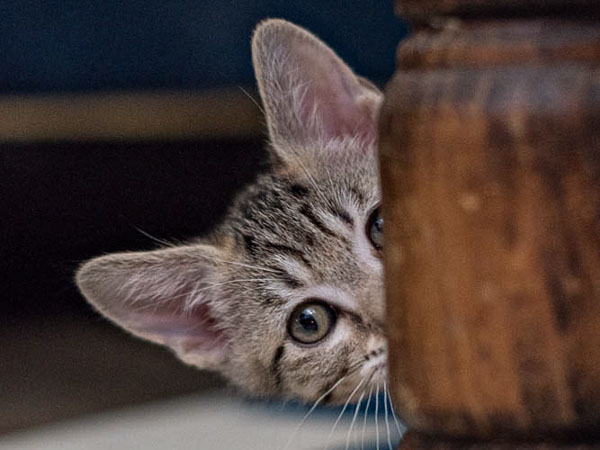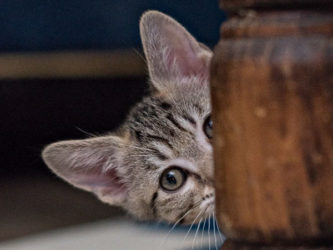
Introducing Your New Cat to the Family

Introducing Your New Cat to the Family
by Nathalie Mireles
Sept. 6, 2019
Congratulations! You just adopted a new family member. Now it is time to introduce the new member to your existing family. This can be stressful on your current dogs or cats as well on the new family member. So how can we minimize the stress and ensure this introduction goes as smoothly as possible for everyone? Let’s go over some steps to make this a fun and happy intorduction!
Try to choose a pet with a similar personality to your own pet. An older dog or cat may not appreciate a rambunctious, energetic kitten.
Give the new addition time to adjust to their new space and new people before introducing to other pets in the house.
Your current pet and your new cat need to be introduced very slowly, so they can get used to each other before they have a face-to-face meeting.
Letting your future friends become familiar with each other’s scents for two to four days may prevent stress that could jeopardize their future friendship.
Initially feed your new pet and your resident pet on opposite sides of a door.
This way they will build a positive association with each other’s scents because eating is something pets generally enjoy.
Over a few days you an gradually move the dishes closer to the door.
Always feed your new pets in separate bowls, don’t let them share food dishes as most fights between new pets occur over food, toys or personal space.
Safety first! No matter how well behaved you think your existing animal is, they can be unpredictable when meeting other animals. Make sure to read the body language of your pets, use caution and closely monitor the interactions until you are 100% comfortable. Always have a plan in place to safely separate the pets if it becomes necessary.
If introducing two cats, try to get your new friends to interact with a toy while safely separated.
Tie a toy to each end of a string and then place it so a toy is on each side of the door.
Encourage them to play tug-of-war or just to interact with the toy on their side of the door. This again will help to make a positive association with the scent of the new cat.
Do some scent swapping.
Rub a different washcloth on each pet and then place the washcloth under the opposite pet’s dish.
Rub a washcloth on each cat and then rub the same washcloth on the opposite cat. This will force each cat to get used to the other cat’s scent.
Swap the bedding between the resident pet and the newcomer to give them more opportunities to get used to each other’s scents.
After your resident cat and your newcomer are comfortable with each other’s scents, you can try a “carrier meeting”. Place your newcomer in a cat carrier and allow the two cats to see and smell each other.
When you finally allow two cats to be together, make sure to suppervise for the first few days.
They may get along fine right from the start or there may be some hissing.
You can try to get them focused on a toy to distract them if they are a little hissy.
Watch the body language for signs of increasing aggression (flattened ears, growling, spitting, swatting, a fluffed tail or crouching) and separate if necessary.
Have a spray bottle and towel ready in case of serious aggression so you can separate the cats.
If aggression is not improving after a few days, a product such as a Feliway diffuser can help to ease the tension.
When introducing a cat to a dog, be sure to put the dog on a leash and remain in control of the dog at all times. Have the dog lay down on the opposite side of the room from where the cat is.
Be aware that dogs (especially bigger ones) can be intimidating for cats, so make sure the dog is calm and controlled, if the dog begins to get excited or aggressive, calm the dog down or remove it from the room until it can calm down so the cat doesn’t feel threatened. Even if a dog is just playing, it can scare the cat or potentially physically harm the cat.
Positive reinforcement is key for both animals! Give your dog a treat for staying in a down position and have a friend give the cat treats.
Do not restrain the cat or force it to stay in the room.
Many short successful visits are better than one long one.
As the cat gets more comfortable, allow it to walk around the room, but keep the dog in a down-stay position. Remember to give your dog treats and praise, so he/she will think the arrival of this new friend is great because it comes with many good things for him/her.
If you are particularly concerned about your dog’s reaction to your new feline friend, get a small stuffed animal that resembles you new cat (at least in size and shape). Rub the stuff animal on your new cat and let your dog get used to the smell. Give your dog treats for being gentle and not showing aggression towards the stuffed friend.
It may take multiple attempts to get them comfortable with each other, so don’t force the interaction or rush the process, just keep trying every day for a few minutes at a time until you see progress.
The goal is for the dog to get to a point where they ignore the cat while on the leash and laying down and don’t seem interested in the new pet. Don’t let them off leash with the cat if they are focused on the cat, whining, pulling or wanting to play. Once the dog ignores the cat, try removing the leash and keeping them down and letting the cat approach the dog instead of vice versa.
Be very careful if you have other small pets in the house such as hamsters, birds, small bunnies, reptiles, fish, etc. Cats do like to hunt by nature and all of these are pets that a cat could harm. Don’t let them on top of their enclosure and don’t allow them to be in the same room unsupervised with a smaller species of animal.
Make sure your existing pet(s) know that you still love them! They can sometimes get jealous of newcomers and act out accordingly, so make sure to balance your time between integrating your new pet and keeping your same routine with your existing pet. Don’t make drastic changes to their environment or schedule. Give them extra love and attention so they know there is plenty to go around and the new pet won’t be displacing them.
Provide plenty of toys so neither pet feels it has to compete for items.
Provide plenty of food so neither pet feels it has to compete for food.
Be sure you and your guests spend as much time greeting and playing with your resident pet as with your new arrival.
Have a great day!

This article may contain links to products on Amazon.com. These links are affiliate links and DREAM Animal Rescue recieves a percentage of the sale for using these links. We use these links as a way to help support the cost of our website.

